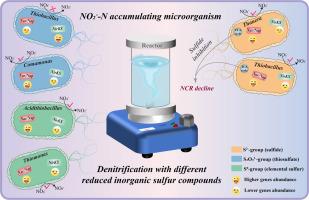利用不同电子供体的硫基反硝化系统中亚硝酸盐积累的元基因组学启示:功能微生物群落和代谢机制
IF 11.4
1区 环境科学与生态学
Q1 ENGINEERING, ENVIRONMENTAL
引用次数: 0
摘要
基于硫的自养反硝化作用(SADN)为亚硝酸盐的供应提供了新途径。然而,氮和硫形式的顺序转化,以及利用不同的还原型无机硫化合物(RISC)驱动 SADN 中亚硝酸盐积累的功能微生物仍不清楚。使用元素硫(S0-基团)、硫化物(S2-基团)和硫代硫酸盐(S2O32-基团)作为电子供体,可以实现理想的亚硝酸盐积累。在同等电子供给条件下,S2O32--组的硝酸盐转化率(NCR)为 0.285 kg N/(m³-d),高于 S2--组(0.103 kg N/(m³-d))。S2 组硝酸盐转化率较低的原因是硫化物强烈抑制了 TCA 循环的能量代谢过程,导致反应速率降低。此外,由于 S0 的化学惰性,S0 组的 NCR(0.035 kg N/(m³-d))较低。特定的微生物群落在门级选择性富集,其中蛋白质细菌的富集程度达到了惊人的 96.27%-98.49%。对功能菌属、基因和代谢途径的综合分析表明,活跃的功能菌属存在显著差异,即使是同一菌属在对不同 RISC 的反应中也表现出显著的代谢差异。在 S0 组中,硫单胞菌(10.0%)和酸性硫杆菌(5.1%)是亚硝酸盐积累的主要贡献者。硫杆菌是 S2--组(43.84%)和 S2O32--组(18.92%)中数量最多的硫氧化细菌。在 S2--组中,它促进了亚硝酸盐的积累,而在 S2O32--组中,它是完全的反硝化菌(NO3--N→N2)。值得注意的是,异养反硝化细菌 Comamonas(12.52%)在 S2O32--组中对亚硝酸盐的积累起着至关重要的作用,它以 NarG 为主,而缺乏 NirK/S。总之,这项工作加深了我们对具有不同RISC的SADN系统的了解,为优化脱氮除硫提供了启示。本文章由计算机程序翻译,如有差异,请以英文原文为准。

Metagenomic insights into nitrite accumulation in sulfur-based denitrification systems utilizing different electron donors: functional microbial communities and metabolic mechanisms
Sulfur-based autotrophic denitrification (SADN) offers new pathway for nitrite supply. However, sequential transformation of nitrogen and sulfur forms, and the functional microorganisms driving nitrite accumulation in SADN with different reduced inorganic sulfur compounds (RISCs), remain unclear. Desirable nitrite accumulation was achieved using elemental sulfur (S0-group), sulfide (S2--group) and thiosulfate (S2O32--group) as electron donors. Under equivalent electron supply conditions, S2O32--group exhibited a superior nitrate conversion rate (NCR) of 0.285 kg N/(m³·d) compared to S2--group (0.103 kg N/(m³·d)). Lower NCR in S2--group was attributed to sulfide strongly inhibiting energy metabolism process of TCA cycle, resulting in reduced reaction rates. Moreover, the NCR of S0-group (0.035 kg N/(m³·d)) was poor due to the chemical inertness of S0. Specific microbial communities were selectively enriched in phylum level, with Proteobacteria increasing to an astonished 96.27-98.49%. Comprehensive analyses of functional genus, genes, and metabolic pathways revealed significant variability in the active functional genus, with even the same genus showed significant metabolic differences in response to different RISCs. In S0-group, Thiomonas (10.0%) and Acidithiobacillus (5.1%) were the primary contributor to nitrite accumulation. Thiobacillus was the most abundant sulfur-oxidizing bacteria in S2--group (43.84%) and S2O32--group (18.92%). In S2--group, it contributed to nitrite accumulation, while in S2O32--group, it acted as a complete denitrifier (NO3--N→N2). Notably, heterotrophic denitrifying bacteria, Comamonas (12.52%), were crucial for nitrite accumulation in S2O32--group, predominating NarG while lacking NirK/S. Overall, this work advances our understanding of SADN systems with different RISCs, offering insights for optimizing nitrogen and sulfur removal.
求助全文
通过发布文献求助,成功后即可免费获取论文全文。
去求助
来源期刊

Water Research
环境科学-工程:环境
CiteScore
20.80
自引率
9.40%
发文量
1307
审稿时长
38 days
期刊介绍:
Water Research, along with its open access companion journal Water Research X, serves as a platform for publishing original research papers covering various aspects of the science and technology related to the anthropogenic water cycle, water quality, and its management worldwide. The audience targeted by the journal comprises biologists, chemical engineers, chemists, civil engineers, environmental engineers, limnologists, and microbiologists. The scope of the journal include:
•Treatment processes for water and wastewaters (municipal, agricultural, industrial, and on-site treatment), including resource recovery and residuals management;
•Urban hydrology including sewer systems, stormwater management, and green infrastructure;
•Drinking water treatment and distribution;
•Potable and non-potable water reuse;
•Sanitation, public health, and risk assessment;
•Anaerobic digestion, solid and hazardous waste management, including source characterization and the effects and control of leachates and gaseous emissions;
•Contaminants (chemical, microbial, anthropogenic particles such as nanoparticles or microplastics) and related water quality sensing, monitoring, fate, and assessment;
•Anthropogenic impacts on inland, tidal, coastal and urban waters, focusing on surface and ground waters, and point and non-point sources of pollution;
•Environmental restoration, linked to surface water, groundwater and groundwater remediation;
•Analysis of the interfaces between sediments and water, and between water and atmosphere, focusing specifically on anthropogenic impacts;
•Mathematical modelling, systems analysis, machine learning, and beneficial use of big data related to the anthropogenic water cycle;
•Socio-economic, policy, and regulations studies.
 求助内容:
求助内容: 应助结果提醒方式:
应助结果提醒方式:


